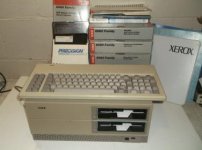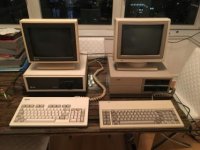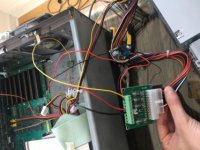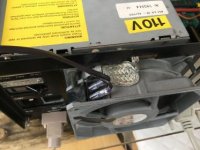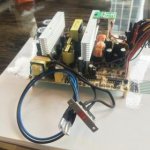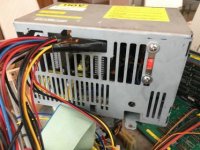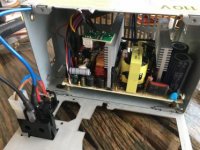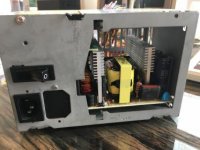Someday I'll understand all of the words in that sentence.
Apologies - that was indeed a bit cryptic. Let me elaborate a bit.
If I had to replace an M24/AT&T power supply with a modern one, I would do the following:
ATX power supply
It seems there is a large number of form factors for modern PC PSUs (eg see
here) but I would stick with the classic ATX. Specifically I would go for a
Startech 300W ATX 20-pin power supply. I have never used this one before but I have bought plenty of Startech products in the past and they were of good durable quality. I have a number of Startech
AT power supplies (sadly, no longer on sale) for my 486 etc. and they are whisper-quiet. No affiliation - just a satisfied customer!
Adapters
The M24 has four main internal DC voltage rail connectors on its power supply.

1. A connector for +5V/GND/GND/+12V for internal drives. Internal drives use the classic 4-pin Molex connectors - no need for adapters here, the ATX power supply can be connected to the drives directly.
2. A +15V/GND connector for monochrome monitors (connector "B" in the photo). We'll get back to this later.
3. A +12V/-12V connector for the ISA bus (connector "A" in the photo)
4. Two large +5V/GND screw posts for the main motherboard/bus converter supply
I think the cleanest way to connect to the ATX PSU is to buy a cheap adapter that has has a 20-pin female ATX connector - something like
this. You will also need a
screw terminal block of sufficient size to accept the two large red/black wires.
Cut off the unwanted end and refer to a
pinout guide like this to connect the following:
- All +5V wires (pins 4, 6, 19, and 20) together into one end of a screw terminal block. Do not connect the wire from pin 9 - that's the +5V
standby (always-on) supply, leave that unconnected.
- At least four GND wires (choose from pins 3, 5, 7, 13, 15, 16, 17) into another one of the screw terminal block openings
- The wire from pin 14 (/PS_ON) to any GND wire. This tells the ATX PSU to switch itself on. Alternatively you can put a switch between /PS_ON and GND and control the PSU that way.
This takes care of the main motherboard/bus converter power supply. Now we need to connect the +12V/-12V line. I don't have access to an original power supply right now so I can't tell exactly what type of connector this is, but I know it's a male connector on the PSU side so at worst we can connect the two wires from the AT PSU (pins 10 and 12 for +12V/-12V) to individual pins (those from
breadboard jumper wires should do) and insert those into the female connector, securing the joint with good old fashioned electrician tape :D. Alternatively we can run a new wire to the motherboard, where the connector is male - I
think individual female dupont connectors would fit, but again I can't be sure until I get a chance to check.
15VDC line
This is where it gets a bit tricky. We need to generate a +15V rail. This is used exclusively to power the monochrome monitor - if you are using an adapter to VGA, this is not needed. I also think this may not be needed by the colour monitor as that has its own power supply, but never having seen one I can't be sure. Anyway, I think the best way to do this is to use a DC-to-DC converter, called a
boost or step-up converter, to obtain +15V from +12V. eBay has a large offering of these, but many are "variable-voltage" output that needs to be trimmed. In my experience I have always found these a bit fiddly - I usually prefer fixed-output-voltage regulators like
this one. Mind the amperage - I would not go below a 2A rating as the M24 Theory of Operations manual specifies a current draw up to 1.8A on this line. I would source the +12V from one of the Molex connectors for the disk drives. The connector is the same physical size as the +12V/-12V one, so the same consideration apply for connecting it up.
Dimensions
All the above should work for a temporary replacement and/or for testing. For a permanent replacement it's worth noting that ATX PSUs are deeper that the M24 one (150mm vs 112mm) so I am not sure if they would fit. At a stretch I guess it would be possible to remove the ATX PSU outer enclosure (!!DANGER!!) and relocate the fan outside of the PSU into the location of the original fan, and house the ATX PSU PCB into a smaller enclosure (possibly re-using the original enclosure if the original PSU is truly beyond repair).
It is also worth mentioning that the workings of the original power supply are documented in beautiful detail in the Theory of Operations manual, so if at all possible troubleshooting and/or repair of original units is worth a try (even though I have never done so myself beyond general cleaning and fuse replacement).
Disclaimer
I have not done any of the things above - this is just theory. Electricity kills. If you don't know what you are doing, don't.
